Room Correction
Digital Room Correction is using a processor to correct the interaction between the speakers and the room.
Proper DRC requires measuring the response using a calibrated microphone at the listening position.
This measurement is used to generate a target curve, one that compensate for the amoralities caused by the interaction between room and speakers.
CamillaDSP
A tool to create audio processing pipelines for applications such as active crossovers or room correction. It is written in Rust to benefit from the safety and elegant handling of threading that this language provides.
Supported platforms: Linux, macOS, Windows.
Audio data is captured from a capture device and sent to a playback device. Alsa, PulseAudio, Jack, Wasapi and CoreAudio are currently supported for both capture and playback.
The processing pipeline consists of any number of filters and mixers.
Mixers are used to route audio between channels and to change the number of channels in the stream. Filters can be both IIR and FIR. IIR filters are implemented as biquads, while FIR use convolution via FFT/IFFT.
A filter can be applied to any number of channels. All processing is done in chunks of a fixed number of samples. A small number of samples gives a small in-out latency while a larger number is required for long FIR filters.
Freeware
camillaNode is a web based interface to control CamillaDSP and use it as an Equalizer.
DRC: Digital Room Correction
DRC is a program used to generate correction filters for acoustic compensation of HiFi and audio systems in general, including listening room compensation. DRC generates just the FIR correction filters, which can be used with a real time or offline convolver to provide real time or offline correction. DRC doesn't provide convolution features, and provides only some simplified, although really accurate, measuring tools.
If you are currently using a computer to serve up your music, you may be interested in trying digital room correction. I've been using correction for many years. I've tried a number of digital room correction software and hardware solutions, ranging in price from free to many thousands of dollars. While I am currently using a hardware solution, a very effective solution is the free and open source DRC package. Unfortunately, DRC is quite difficult to learn to configure and use effectively.
A few months ago I started spending some free time writing software to make the process of creating impulse responses and digital correction filters easier with DRC. Basically the program is a graphical interface to the impulse recording and filter creation process. You can record impulses at different sample rates and easily create the standard filters that some with DRC, but also create filters suited to your tastes with the customized filter feature. The program will automatically create the configuration files to load filters in convolver VST, which is also included in the release (as well as DRC). The program currently only works under Microsoft Windows but I am planning on releasing a Linux version when I am happy with the Windows version.
Digital Room Correction Designer was created to ease the process of creating and loading room correction filters for use with two channel stereo systems. DRC Designer includes Denis Sbragion's DRC for creating room correction filters, John Pavel's Convolver VST for playing music through the filters, and Simple Automated IR Measuring Tool by Denis Sbragion and Edward Wildgoose for creating the impulse response files needed by DRC.
(((acourate)))® delivers both state-of-the-art digital room-correction and speaker driver-time-alignment, linearization & crossover execution in an upgradable, customizable pc-based solution.
Generates correction filters for a wide range of convolution applications like BruteFIR, Convolver, X-volver, Foobar2000, Inguz Room Correction
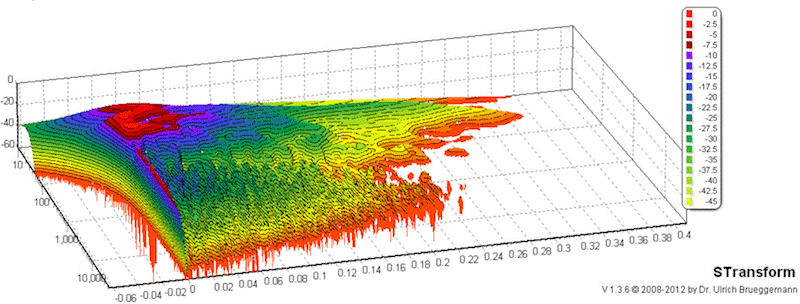
A single user license for private, non-commercial use of (((acourate)))® is 340 € (incl. VAT)
You can do a lot with Acourate
- Create a digital crossover..
- Time align the drivers.
- Linearize each driver.
- Room correction.
Digital Room Correction with AudioVero's Acourate - Archimago's Musings
Audiolense
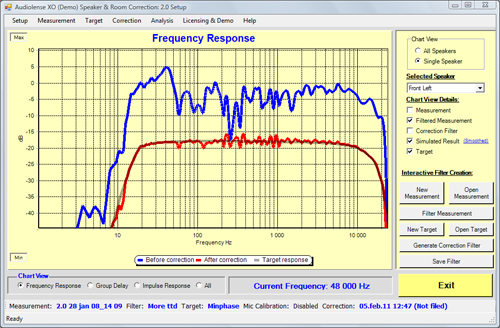
We are confident that Audiolense is at the forefront of audio correction. The verdict from those who have moved from competing solutions have been positive - and the verdict from those who didn't have prior experience with advanced sound correction have been overwhelming since the early days. That includes Audiolense XO - our high-end offering with True Time Domain correction as well as our entry level offerings Audiolense 2.0 and Audiolense Surround - that both utilizes a very good frequency correction.
Source: Juice HiFI
Ultimate Equalizer 2.0 HT
Ultimate Equalizer (UE-PC). The UltimateEqualizer is a much enhanced, and completely free-standing version of the UE dialogue box built-into SoundEasy V17, and some concepts have been developed in collaboration with Music and Design. The UE consists of the following main blocks:
- MLS measurement system with full post-processing.
- Importing SPL/Phase from other measurement systems.
- Diffraction modelling function.
- Driver File Editor function for HBT application.
- The Ultimate Equalizer Module, comprising of all necessary functions for building and equalizing up to 2 x 4-way system.
- Latest release of the UE-PC incorporates 5.1 Home Theatre option for use with Delta 1010LT sound card.
The UE includes inverse-HBT equalization, time-inverse processing that eliminates phase distortion, crossover filtering, and partitioned convolution. Equalization of the individual drivers’ response to the user specified acoustic target is performed automatically with the click of a button. The outcome is a transient perfect speaker system with flat amplitude and phase responses that faithfully reproduces any input signal relative to the design point, as demonstrated by the ability of the speaker system to play undistorted square waves. Shelving and notch filters are included to voice the speaker to other than ruler flat response and the time-inverse processing and be switched on or off as desired. Recommended sound card is MME/WDM compatible 2-in/8-out sound card. Many functions will look familiar to SoundEasy users, but you will find them simplified, with better GUI. This stand-alone, fully self-containing program includes ALL functions, that you need to create your "DSP-on-PC" system. Latest release of the UE-PC incorporates 5.1 Home Theatre option
Source: Bodzio Software
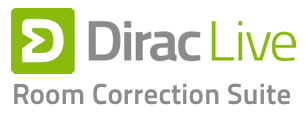
- Optimizes impulse response and frequency response (mixed-phase) in multiple positions
- 96 KHz / 24 bit support
- Compatible with Win 7, Vista; as well as OSX 10.6 - 10.7. Not yet officially supported on
Win XP and OS X 10.4 - 10.5 (but should still work) - Multi-channel support
- Microphone kit can be included (mic, USB pre-amp, cables, clip)
- Measure and calibrate speakers and room
- Play and process with PC or Mac 2
€ 650
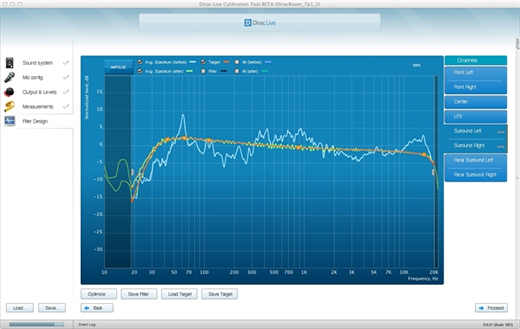
MathAudio Auto EQ VST
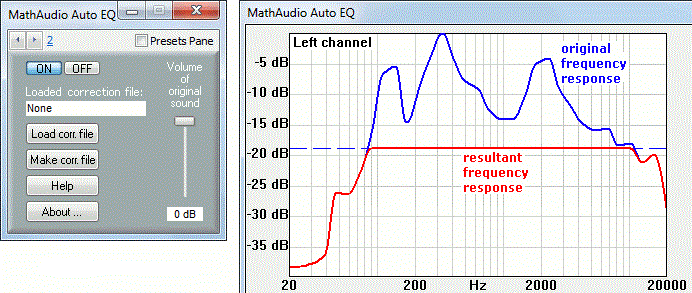
- Corrects acoustic imperfections of speakers, headphones and earphones.
- Corrects deficiencies of room acoustics (multipoint compensation).
- Corrects both amplitude and phase components of frequency response.
- Quells resonance peaks of frequency response while leaving the deep notches to prevent large excursions of the speaker diaphragm. Avoids the muddy sound of conventional linearizing equalizers.
- Contains built-in frequency responses of ideal speakers, headphones and earphones and uses them as references.
- Allows drawing one's own reference frequency response.
- Allows correction of more than two speakers simultaneously by means of loading multiple instances of the plug-in and using different correction files in each instance.
- Manually adjustable level of compensation allows one to reach the maximum transparency of the sound.
- Perfect for use with standard measurement microphones. Even a cheap measurement microphone like Behringer ECM8000 ensures the accuracy of +/- 2 dB which is enough for professional musical applications.
- A patented method of the frequency response correction ensures maximum accuracy of the compensation.
$99.95
REW- Room EQ Wizard
REW is room acoustics analysis software for measuring and analysing room and loudspeaker responses. It includes tools for generating audio test signals; measuring SPL and impedance; measuring frequency and impulse responses; generating phase, group delay and spectral decay plots, waterfalls, spectrograms and energy-time curves; generating real time analyser (RTA) plots; calculating reverberation times; calculating Thiele-Small parameters; determining the frequencies and decay times of modal resonances; displaying equaliser responses and automatically adjusting the settings of parametric equalisers to counter the effects of room modes and adjust responses to match a target curve. The audio analysis features of REW help you optimise the acoustics of your listening room, studio or home theater and find the best locations for your speakers, subwoofers and listening position.
Price: freeware


